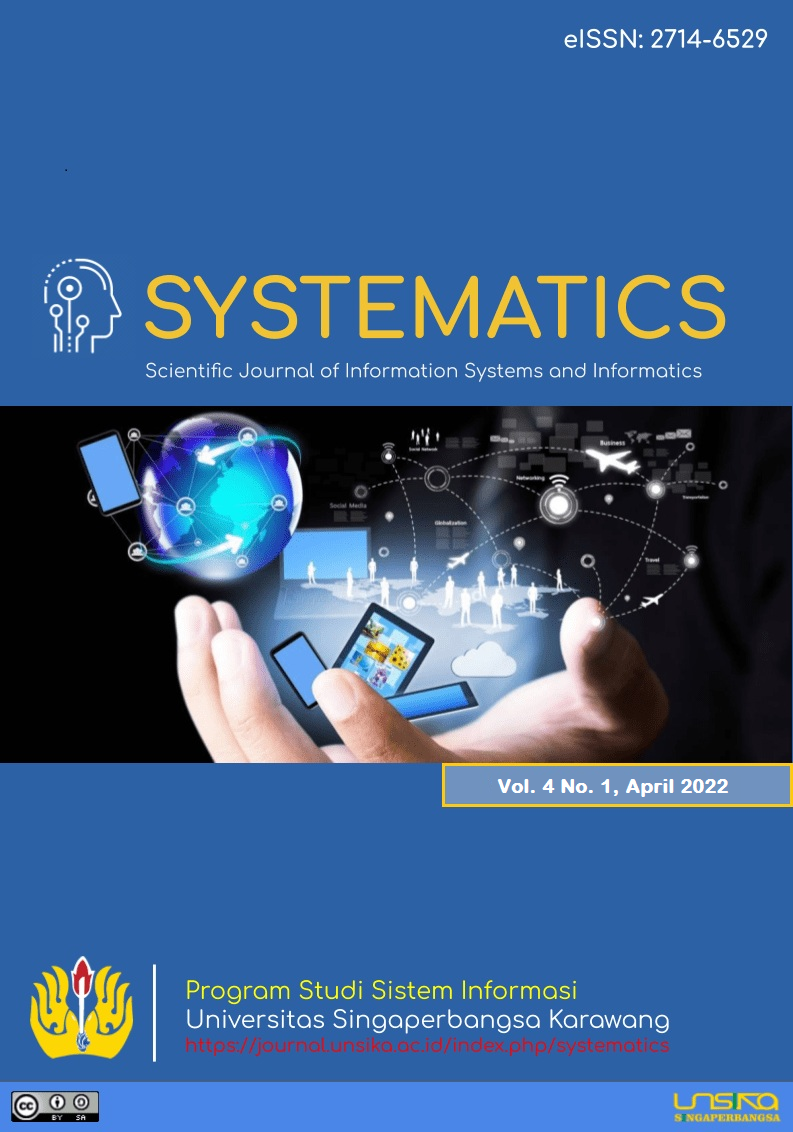Sentiment Analysis Dataset on COVID-19 Variant News
Kumpulan Data Analisis Sentimen pada Berita Varian COVID-19
DOI:
https://doi.org/10.35706/sys.v4i1.6347Abstract
The development of technology at this time is getting faster and faster, this is indicated by the number of emerging social media such as Facebook, Instagram, Twitter. Twitter is used as a forum for users to discuss, express opinions, and share stories between users, because many people today often have opinions about the COVID-19 outbreak, plus there are new variants that make people express various types of opinions, both good and bad. good and so on. Therefore, an effort was made to research the covid variant to see labeling sentiment, which in essence is a text mining process that aims to extract sentiment from text using regular expressions so that labels are obtained for each text in the dataset, so a dataset is formed that can be used for further research. The process includes data collection including (scrapping tweets, data tweets), pre-processing (case folding, remove URLs, remove stop words, change into standard words, stemming, tokenization), sentiment labeling (IR in the form of regular expressions, sentiment labeling), and data visualization show pie chart, show word cloud). Of the 8993 tweets that have been analyzed, 2213 positive tweets, 1735 negative tweets, and 5045 neutral tweets were found.
Downloads
References
G. Xu et al., “Spatial disparities of self-reported COVID-19 cases and influencing factors in Wuhan, China,” Sustain. Cities Soc., vol. 76, no. September 2021, p. 103485, 2022.
A. Voutama, I. Maulana, and N. Ade, “Interactive M-Learning Design Innovation using Android-Based Adobe Flash at WFH (Work From Home),” Sci. J. Informatics, vol. 8, no. 1, pp. 127–136, 2021, doi: 10.15294/sji.v8i1.27880.
R. Ferdiana, F. Jatmiko, D. D. Purwanti, A. S. T. Ayu, and W. F. Dicka, “Dataset Indonesia untuk Analisis Sentimen,” J. Nas. Tek. Elektro dan Teknol. Inf., vol. 8, no. 4, p. 334, 2019.
C. Wang and X. Gu, “Influence of adolescents’ peer relationships and social media on academic identity,” Asia Pacific J. Educ., vol. 39, no. 3, pp. 357–371, 2019.
K. K. Kapoor, K. Tamilmani, N. P. Rana, P. Patil, Y. K. Dwivedi, and S. Nerur, “Advances in Social Media Research: Past, Present and Future,” Inf. Syst. Front., vol. 20, no. 3, pp. 531–558, 2018, doi: 10.1007/s10796-017-9810-y.
A. Voutama and E. Novalia, “Perancangan Aplikasi M-Magazine Berbasis Android Sebagai Sarana Mading Sekolah Menengah Atas,” J. Tekno Kompak, vol. 15, no. 1, p. 104, 2021, doi: 10.33365/jtk.v15i1.920.
N. Nyoman, P. Pinata, I. M. Sukarsa, N. Kadek, and D. Rus jayanthi, “Prediksi Kecelakaan Lalu Lintas di Bali dengan XGBoost pada Python,” J. Ilm. Merpati, vol. 8, no. 3, pp. 188–196, 2020.
D. N. Zuraidah, M. F. Apriyadi, A. R. Fatoni, M. Al Fatih, and Y. Amrozi, “Menelisik Platform Digital Dalam Teknologi Bahasa Pemrograman,” Teknois J. Ilm. Teknol. Inf. dan Sains, vol. 11, no. 2, pp. 1–6, 2021.
I. Ruslianto, S. Bahri, J. Rekayasa Sistem Komputer, and J. H. Hadari Nawawi, “Analisa Log Web Server Untuk Mengetahui Pola Perilaku Pengunjung Website Menggunakan Teknik Regular Expressions,” Coding J. Komput. dan Apl., vol. 07, no. 01, pp. 120–130, 2019.
S. Salomon and S. Hansun, “Spam Filter Situs Jejaring Sosial Mahasiswa Menggunakan Regular Expression,” J. Ultim. InfoSys, vol. 8, no. 2, pp. 69–73, 2018.
F. Tobing and R. Nainggolan, “Analisis Perbandingan Penggunaan Metode Binary Search Dengan Regular Search Expression,” METHOMIKA J. Manaj. Inform. dan Komputerisasi Akunt., vol. 4, no. 1, pp. 168–172, 2020, doi: 10.46880/jmika.v4i2.202.
D. H. Wahid and A. SN, “Peringkasan Sentimen Esktraktif di Twitter Menggunakan Hybrid TF-IDF dan Cosine Similarity,” IJCCS (Indonesian J. Comput. Cybern. Syst., vol. 10, no. 2, p. 207, 2016.
A. A. Chaudhri, S. S. Saranya, and S. Dubey, “Implementation Paper on Analyzing COVID-19 Vaccines on Twitter Dataset Using Tweepy and Text Blob,” Ann. Rom. Soc. Cell Biol., vol. 25, no. 3, pp. 8393–8396, 2021.
R. Wati et al., “Analisis Sentimen Persepsi Publik Mengenai PPKM Pada Twitter Berbasis SVM Menggunakan Python,” vol. 06, pp. 240–247, 2021.
A. Voutama, “Perancangan Aplikasi M-Discussion Berbasis Android Sebagai Wadah Diskusi Sekolah,” Syntax J. Inform., vol. 7, no. 2, pp. 116–124, 2018.
D. Arisandi, Z. Indra, and K. Kartini, “Mengidentifikasi Hoax Pada Hasil Pencarian Berita Online Dengan Teknik Web Scraping Dan Algoritma C4.5,” Rabit J. Teknol. dan Sist. Inf. Univrab, vol. 6, no. 2, pp. 130–137, 2021.
W. Budiharto and M. Meiliana, “Prediction and analysis of Indonesia Presidential election from Twitter using sentiment analysis,” J. Big Data, vol. 5, no. 1, pp. 1–10, 2018.
Z. Wu and D. C. Ong, “Context-Guided BERT for Targeted Aspect-Based Sentiment Analysis,” 2020.
A. Priyanto and M. R. Ma’arif, “Implementasi Web Scrapping dan Text Mining untuk Akuisisi dan Kategorisasi Informasi dari Internet (Studi Kasus: Tutorial Hidroponik),” Indones. J. Inf. Syst., vol. 1, no. 1, pp. 25–33, 2018.
A. Javed, M. Zaman, M. M. Uddin, and T. Nusrat, “An analysis on python programming language demand and its recent trend in bangladesh,” PervasiveHealth Pervasive Comput. Technol. Healthc., pp. 458–465, 2019.
Downloads
Published
How to Cite
Issue
Section
License
Copyright (c) 2022 SYSTEMATICS

This work is licensed under a Creative Commons Attribution-ShareAlike 4.0 International License.
Authors who publish with this journal agree to the following terms:
- Authors retain copyright and grant the journal right of first publication with the work simultaneously licensed under a Creative Commons Attribution-ShareAlike 4.0 International License. that allows others to share the work with an acknowledgement of the work's authorship and initial publication in this journal.
- Authors are able to enter into separate, additional contractual arrangements for the non-exclusive distribution of the journal's published version of the work (e.g., post it to an institutional repository or publish it in a book), with an acknowledgement of its initial publication in this journal.
- Authors are permitted and encouraged to post their work online (e.g., in institutional repositories or on their website) prior to and during the submission process, as it can lead to productive exchanges, as well as earlier and greater citation of published work (See The Effect of Open Access).







